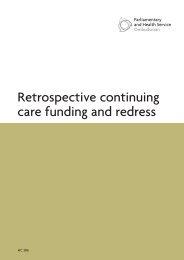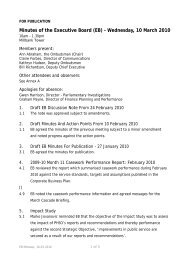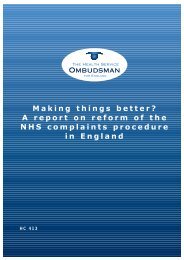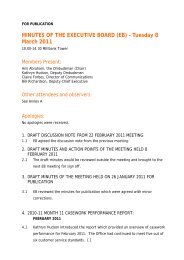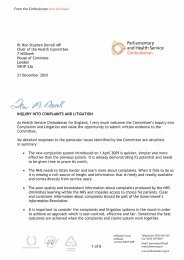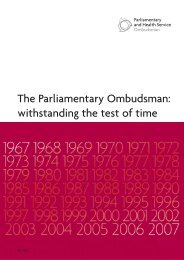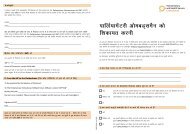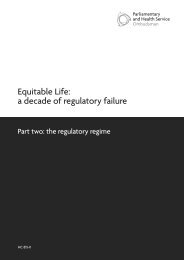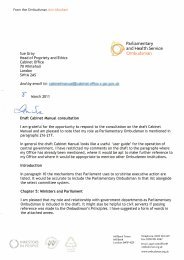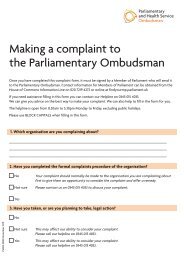Putting things right: complaints and learning from DWP - the ...
Putting things right: complaints and learning from DWP - the ...
Putting things right: complaints and learning from DWP - the ...
Create successful ePaper yourself
Turn your PDF publications into a flip-book with our unique Google optimized e-Paper software.
Mr Q’s complaint about Jobcentre Plus<br />
<strong>and</strong> <strong>the</strong> Child Benefit Office<br />
In <strong>the</strong> case of Mr Q, Jobcentre Plus’s efforts to inform widowed fa<strong>the</strong>rs that <strong>the</strong>y could claim<br />
bereavement benefits, following a change in <strong>the</strong> law, were inadequate. As a result, Mr Q remained<br />
unaware that he was eligible for widowed parent’s allowance <strong>and</strong> so did not make a claim for over<br />
four years.<br />
Background to <strong>the</strong> complaint<br />
Before 9 April 2001, bereavement benefits were<br />
only available to married women whose husb<strong>and</strong>s<br />
had died. Following a change in <strong>the</strong> law, widowed<br />
mo<strong>the</strong>r’s allowance was replaced by <strong>the</strong> new<br />
widowed parent’s allowance <strong>from</strong> 9 April 2001,<br />
which was payable to widows <strong>and</strong> widowers alike.<br />
One of <strong>the</strong> eligibility criteria was that applicants<br />
had to be entitled to child benefit for at least one<br />
qualifying child. Claims could only be backdated<br />
three months at most.<br />
In general, unless asked, <strong>the</strong>re is no onus on<br />
Jobcentre Plus to inform people that <strong>the</strong>y may be<br />
eligible to claim a particular benefit. This is not<br />
<strong>the</strong> case, however, when a change in statutory<br />
provisions gives rise to new entitlements.<br />
In such cases, departments should act reasonably<br />
in taking such steps as may be practicable to<br />
identify those with an entitlement <strong>and</strong> ei<strong>the</strong>r pay<br />
<strong>the</strong>m that entitlement or invite <strong>the</strong>m to claim.<br />
This is set out in a 1979 report by <strong>the</strong> <strong>the</strong>n Civil<br />
Service Department, Legal Entitlements <strong>and</strong><br />
Administrative Practices. In <strong>the</strong> lead-up to <strong>the</strong><br />
April 2001 changes, Jobcentre Plus considered<br />
how to tell existing widowers about <strong>the</strong> changes.<br />
Most of <strong>the</strong> papers relating to this work have<br />
been destroyed but it is clear that Jobcentre Plus<br />
decided first that <strong>the</strong>y would conduct a ‘scan’<br />
of <strong>the</strong> child benefit database to try to identify<br />
existing widowers whom <strong>the</strong>y would <strong>the</strong>n<br />
write to, <strong>and</strong> secondly that <strong>the</strong>y would run a<br />
publicity campaign.<br />
Informing widowers of <strong>the</strong> April 2001 changes –<br />
Jobcentre Plus’s publicity campaign<br />
Jobcentre Plus considered a variety of options,<br />
including coverage in national, women’s <strong>and</strong><br />
regional press; advertorials <strong>and</strong> advertisements in<br />
local <strong>and</strong> regional press; national press advertising;<br />
<strong>and</strong> a dedicated leaflet distributed in <strong>the</strong> wider<br />
community. Although <strong>the</strong>y thought about how<br />
best to target men, we saw no evidence that <strong>the</strong>y<br />
gave any consideration to <strong>the</strong> question of how<br />
best to target publicity to bereaved men. The<br />
extent of <strong>the</strong> final publicity campaign was unclear,<br />
but Jobcentre Plus were able to provide us with<br />
only 21 press cuttings for <strong>the</strong> 8 months following<br />
<strong>the</strong> change in <strong>the</strong> law that mentioned it, <strong>and</strong> of<br />
those several were reports of a charity’s statement<br />
warning that <strong>the</strong>re had been insufficient publicity.<br />
In March 2001 ano<strong>the</strong>r charity, which offers help to<br />
bereaved people, wrote to <strong>the</strong> Secretary of State<br />
about <strong>the</strong> ‘minimal publicity for <strong>the</strong> new benefits’,<br />
<strong>and</strong> expressed concern that without publicity<br />
some potential claimants were unlikely to claim <strong>the</strong><br />
benefits, particularly men with dependent children<br />
who had been widowed for some time. There is no<br />
record of any reply.<br />
Informing widowers of <strong>the</strong> April 2001 changes – <strong>the</strong><br />
Child Benefit Office scan<br />
The child benefit database was not designed<br />
to identify widowers <strong>and</strong> so <strong>the</strong> scan was not<br />
a straightforward exercise. A first scan looked<br />
for claims with a sole male payee with a<br />
cross‐reference to ano<strong>the</strong>r child benefit number<br />
(<strong>the</strong> original claim would usually have been made<br />
26 <strong>Putting</strong> <strong>things</strong> <strong>right</strong>: <strong>complaints</strong> <strong>and</strong> <strong>learning</strong> <strong>from</strong> <strong>DWP</strong> | March 2009



